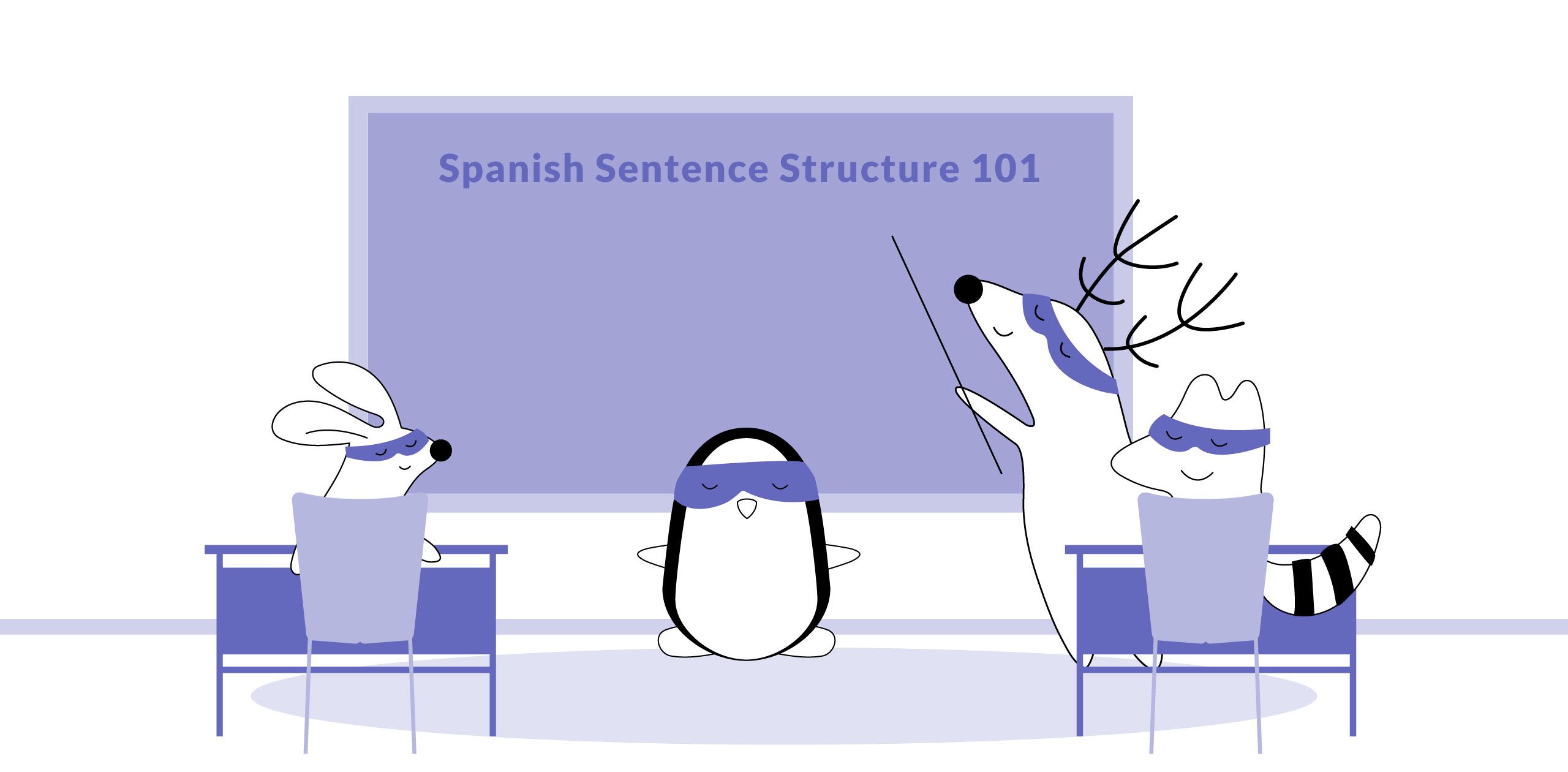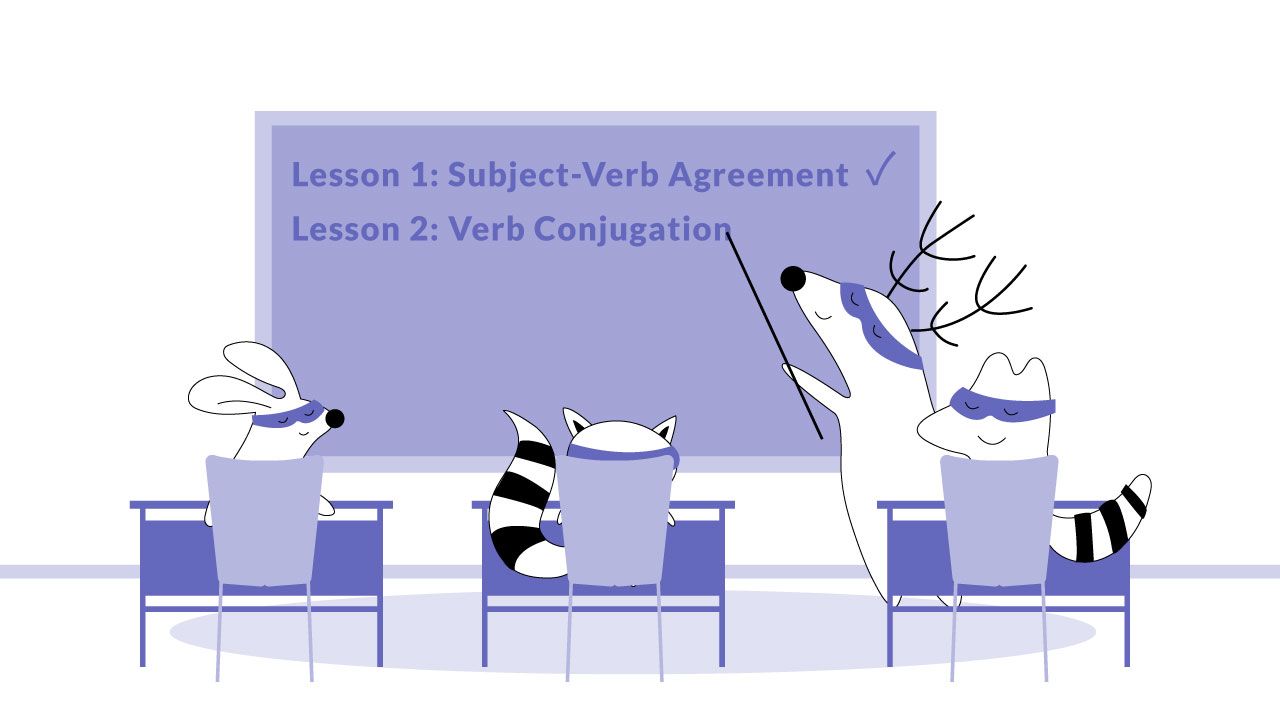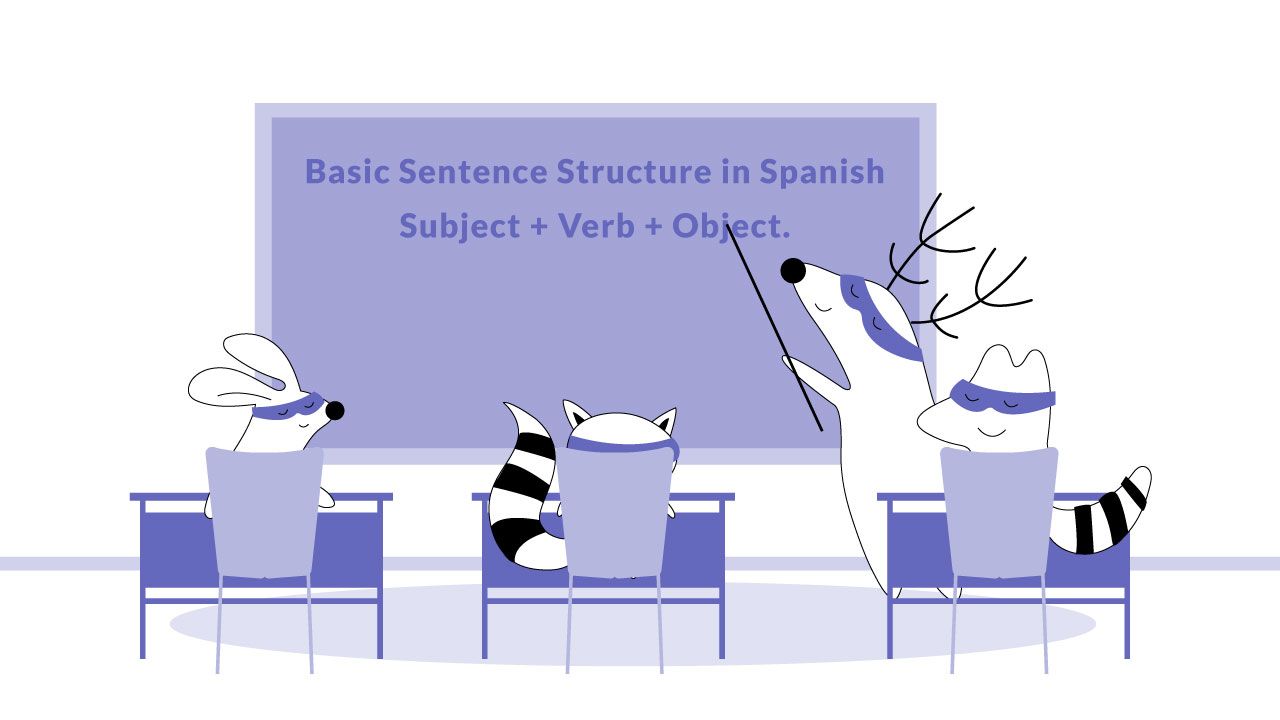We might not always like to admit this when we’re starting to learn a language, but the truth is that one can’t speak properly without knowing how to put sentences together. If you use the wrong word order, there’s a chance that what you’re saying might have a different meaning than what you intended, or it might have no meaning at all.
To avoid this, here’s the perfect article for you to learn Spanish sentence structure. You’ll soon learn that Spanish word order is actually not so hard, and that, in some ways, it’s similar to word order in English. You’ll also learn that, in fact, it’s more flexible! That means you can change the order of words a little bit more than you can in English.
Table of Contents
- Overview of Word Order in Spanish
- Basic Word Order with Subject, Verb, and Object
- Word Order in Negative Sentences
- Word Order with Prepositional Phrases
- Word Order with Modifiers
- Changing a Sentence into a Yes-or-No Question
- Translation Exercises
- How to Master Spanish with SpanishPod101.com
1. Overview of Word Order in Spanish
Basic Spanish language word order refers to the usual order in which words are found in a sentence. Even though the sentences that we use day-to-day may have other elements in them, to learn this basic order, there are three basic elements that we use as a reference. These three elements are the subject, verb, and object.
Despite Spanish being more flexible than English in this sense, our basic word order is the same:
subject + verb + object (SVO)
Yo + me comí + la tarta
I + ate + the cake
Sometimes, we might want to emphasize one element or another in a sentence. This leads us to moving these around the sentence, but they will keep the same (or very similar) meaning. In English, because the ability to move words in a sentence is quite limited, emphasizing an element is accomplished by intonation.
Let’s look at two sentences. The first one has basic word order, and the other one has a different order. In the second sentence, the emphasized word is marked in bold:
Example: Yo me comí la tarta.
Translation: “I ate the cake.”
Example: Me la comí yo, la tarta.
Translation: “I ate the cake.”
There’s a way of modifying the English sentence to emphasize this element even more: “It is I that ate the cake.” However, this wouldn’t be an accurate translation of our example in Spanish, because in English, we’re not just moving an element around: we’re changing the whole structure.
Did you notice that we actually added an extra word in our second Spanish sentence? If you did, we just want to say: Nice job! The word that we added was a pronoun, and don’t worry, we’ll explain it a little bit later.
We could still modify our sample sentence a bit more:
Example: La tarta me la comí yo.
Translation: “The cake, I ate.”
In this case, we can translate this new structure pretty much literally, but in English, we feel like this sounds quite unnatural. In Spanish, this is completely normal.
2. Basic Word Order with Subject, Verb, and Object
Now, let’s go more into detail about the most basic Spanish word order rules.
1 – Subject
Subject is the person or thing performing the action of the verb. It’s usually a noun phrase, such as a noun or a pronoun: Juan come espaguetis. (“Juan eats spaghetti.”) / Él come espaguetis. (“He eats spaghetti.”).
Sometimes, the subject might be a verb: Cantar es divertido. (“Singing is fun.”). However, as we’ve explained in previous articles, in Spanish, a subject isn’t always necessary and we often drop pronouns when we already know who the subject is: Como espaguetis. (“I eat spaghetti.”).
As we saw in our previous article about verb conjugation in Spanish, the verb como is conjugated, and considering the verb is conjugated in the first person singular, we know it means “I eat,” so there’s no possible confusion.
2 – Verb
The second element in Spanish word order is verbs. You know what verbs are, don’t you? According to the Cambridge Dictionary, a verb is “a word or phrase that describes an action, condition, or experience.”
To give you a few examples: cantar (“to sing”), comer (“to eat”), and hablar (“to talk”) are all verbs. Without them, language wouldn’t make much sense.
3 – Object
The third and last element in basic word order is something we call an object. It isn’t an indispensable element in a sentence, as some verbs don’t require objects, but it’s undoubtedly common and helps us define sentence structure.
Cambridge defines an object as “a noun or noun phrase that is affected by the action of a verb or that follows a preposition.” In the sentence Juan come espaguetis. (“Juan eats spaghetti.”), spaghetti is the thing that is being eaten by Juan.
3. Word Order in Negative Sentences
In some languages, negative sentences can completely change an affirmative sentence. Lucky for you, in this sense, Spanish happens to be quite simple. So, what is the Spanish word order for these negative sentences?
To form a regular negative sentence, all we need to do is add the word no, which in this context is equivalent to “not,” to an affirmative sentence. No is always found before the verb. To illustrate this, let’s use the same example we did before: Juan no come espaguetis. (“Juan does not eat spaghetti.”).
As you know, there are other ways of making a negative sentence. One example would be to add nunca (“never”): Juan nunca come espaguetis. (“Juan never eats spaghetti.”). As you can see, it follows exactly the same structure as the previous example. Simple, right?
Well, there are many other negative words: nada (“nothing”), nadie (“nobody”), ninguno (“none”)… When we use these words, the structure is a bit different, because they can be used in different ways. They can act as subjects or as objects.
For example: Nadie ha comido espaguetis. (“Nobody has eaten spaghetti.”). Here we find the word nadie before the verb, just as we saw in the previous negative sentences. However, that makes sense, because it acts as a subject.
Since we’re mentioning this, we should explain that sometimes these words might be found after the verb, even if they’re a subject. Here are a few examples:
- No hay nadie. → “There isn’t anyone.”
- No hay nada. → “There isn’t anything.”
- No queda ninguno. → “There is none left.”
The negative word in bold in each of these examples is the subject of the sentence, even though it might not be as obvious as in the other examples we’ve seen. We could say that the word in bold is “the thing that isn’t.”
As you might have noticed, the adverb no does appear at the beginning of the sentence, something that happens similarly in the English translation. As you’ll find out in our lesson “How to Be Negative?” in Spanish, it’s quite common to have more than one negative word in one sentence.
4. Word Order with Prepositional Phrases
Another element that needs to be taken into account when talking about word order is prepositional phrases. A prepositional phrase is a type of phrase that always begins with a preposition, such as en (“in,” “on,” “at”) or con (“with”). If you would like to find out more about prepositions, we have an article just for you! Check out our article about Spanish prepositions.
Prepositional phrases are usually found at the end of a sentence, but some of them can be placed at the beginning if you want to emphasize said phrase. Let’s look at some examples of Spanish word order that show this:
Estudio español en casa. → “I study Spanish at home.”
But what if someone asked us:
¿Dónde estudias español? → “Where do you study Spanish?”
In this case, a possible answer we could give them would be:
En casa, estudio español. → “At home, I learn Spanish.”
There are many other prepositional phrases we could add to the same sentence, even together, such as:
Estudio español en casa con SpanishPod101.com. → “I study Spanish at home with SpanishPod101.com.”
5. Word Order with Modifiers
We’ve already seen a type of modifier, which were the ones that turned affirmative sentences into negative sentences. However, there are many more elements in sentences that we call modifiers. These include words such as articles, adjectives, and pronouns.
Determiners are easy, because they always go in front of a noun, just like in English. These are, among others, articles, numerals, and possessives. Let’s look at examples for these types of modifiers:
Articles: El hombre come espaguetis. → “The man eats spaghetti.”
Numerals: Dos hombres comen espaguetis. → “Two men eat spaghetti.”
Possessives: Mi padre come espaguetis. → “My father eats spaghetti.”
However, in Spanish word order, adjectives normally go after the noun, but there are exceptions. For example, in literature, especially poetry, it’s common to write the adjective before the noun. Check out our article on adjectives for more information!
El coche blanco es de mi padre. → “The white car is my dad’s.”
La hermosa princesa abrió los ojos. → “The beautiful princess opened her eyes.”
Pronouns can go either before or after the verb, depending on the kind of pronoun they are, or sometimes depending on what you feel like saying. As we learned in our previous article about pronouns, there are different kinds of pronouns in Spanish. Even though we also talked about the order they follow in that article, we’ll look at them again, one by one:
1 – Personal Pronouns
If you read the article we just mentioned, you might remember that there are many kinds of personal pronouns.
a) Subject Pronouns
Subject pronouns, which are the ones we use for the subject of a sentence, are always found before the verb. This is because, as we saw, in Spanish, the subject is always the first element in a sentence.
Ellos quieren una casa nueva. → “They want a new house.”
b) Direct and Indirect Object Pronouns and Reflexive Pronouns
You probably remember that basic word order in Spanish is subject + verb + object, don’t you? Well, when a direct or indirect object is substituted by a pronoun, the pronoun is actually found before the verb. We’ll illustrate this with a few examples:
Direct object:
Quieren una casa nueva. → La quieren.
“They want a new house.” → “They want it.”
Both direct and indirect objects:
Traigo un regalo para mi madre. → Le traigo un regalo. → Se lo traigo.
“I bring a present for my mom.” → “I bring her a present.” → “I bring it to her.”
Reflexive pronouns work in a very similar way and they’re always found before the verb:
Mis padres se van de vacaciones. → “My parents are going on vacation.”
c) Prepositional Pronouns
Prepositional pronouns follow the same rules that prepositional phrases do, so they can be in different locations inside a sentence depending on what you would like to emphasize.
Sin ti todo es diferente. → “Without you, everything is different.”
Todo es diferente sin ti. → “Everything is different without you.”
d) Possessive Pronouns
A possessive pronoun can be a subject or an object, so its order will depend on the function it does in the sentence:
El nuestro es ese. → “Ours is that one.”
La casa es nuestra. → “The house is ours.”
2 – Demonstrative Pronouns
Just like what happened with possessive pronouns, demonstrative pronouns can be in different places in the same sentence, depending on their function.
Este es mi hermano. → “This is my brother.”
Nunca he estado ahí. → “I have never been there.”
3 – Interrogative Pronouns
Interrogative pronouns are pronouns that help us ask questions, and they’re always the first word in a question:
¿Qué quieres? → “What do you want?”
4 – Indefinite Pronouns
Once again, indefinite pronouns don’t have a specific position in a sentence, because that depends on their function.
Todos quieren dinero. → “Everyone wants money.”
Puedes preguntárselo a cualquiera. → “You can ask anyone.”
5 – Relative Pronouns
Relative pronouns are never found in simple sentences. Rather, we find them in complex sentences. These pronouns always start the second part of the sentence, so they’ll always be in the middle. This might sound odd if you’re not sure what a relative pronoun is, but you’ll understand once you look at an example:
Esta es mi prima que vive en la ciudad. → “This is my cousin who lives in the city.”
6. Changing a Sentence into a Yes-or-No Question
In many languages, to transform a normal sentence into a yes-or-no question you must change it a fair bit, or change the order. In Spanish, this is way simpler. So, what is the Spanish word order in questions? Look at these examples:
Estudias español todos los días. → “You study Spanish every day.”
¿Estudias español todos los días? → “Do you study Spanish every day?”
As you probably noticed, it’s exactly the same structure. This doesn’t only happen with specific structures: it happens every time you turn a sentence, either affirmative or negative, into a yes-or-no question.
We’re sure you enjoyed learning this, but you probably know that there are other kinds of questions. If you feel a bit lost when it comes to this topic, you might enjoy our lesson on 15 Questions You Should Know.
7. Translation Exercises
We thought it would be useful to you to see how we transform a simple sentence into more complex sentences, and translate them to English. Below, you can see exactly what changes we make.
1. Bebiste agua. → “You drank water.”
2. Bebiste agua hace cinco minutos. → “You drank water five minutes ago.”
In this second sentence, the only thing we added was the time the action happened, hace cinco minutos, which means “five minutes ago.”
3. Bebiste dos botellas de agua hace cinco minutos. → “You drank two bottles of water five minutes ago.”
In this third sentence, we made a bigger change. This time, what we’re drinking isn’t just water, but something slightly more specific: two bottles of water. The new object is dos botellas de agua instead of just agua.
4. ¿Bebiste dos botellas de agua hace cinco minutos? → “Did you drink two bottles of water five minutes ago?”
To end these examples, we thought it would be a good idea to show you once again how to turn an affirmative sentence into a question, to convince you that we don’t have to make any changes to it, just in case you didn’t believe us before!
8. How to Master Spanish with SpanishPod101.com
As we mentioned previously, Spanish word order is more flexible than English word order, so in some cases, if you don’t use our basic order, it might just seem as if you’re trying to emphasize some word or phrase in particular. The way we see it, it means you would have to try pretty hard to get it wrong! When learning a foreign language, this is exactly the kind of motivation you need.
For more information on Spanish word order, SpanishPod101.com has another short lesson on this as well! If you want to get a better understanding of Spanish grammar in general, also check out our relevant page.
No matter what your level is, give us a try and learn Spanish! From beginner to advanced, here you’ll find everything you need.
Before you go, let us know in the comments if there’s anything that’s still not clear about Spanish word order. We’ll do our best to help you out!

Word Order
Spanish is more flexible than English is with word placement
Roberto estudia. (Roberto is studying.).
Tom Merton/Caiaimage/Getty Images
The subject of word order in Spanish can be quite complex, so this lesson should be considered merely an introduction. As you study Spanish, you will encounter a wide variety of ways of ordering words in a sentence, many of them ways that are impossible or awkward in English.
In general, Spanish is more flexible with its word order than English is. In both languages, a typical statement consists of a noun followed by a verb followed by an object (if the verb has an object). In English, variations from that norm are used mostly for literary effect. But in Spanish, changes in the word order can be heard in everyday conversation or seen frequently in everyday writing such as that found in newspapers and magazines.
Typical Word Orders
The chart below shows examples of some common ways of ordering words. Note that in many sentences the subject can be omitted if it can be understood from the context. As a beginning student, you don’t need to memorize these word-order possibilities, but you should be familiar with these common schemes so you don’t trip over them when you come across them.
| Type | Order | Example | Comment |
| Statement | Subject, verb | Roberto estudia. (Roberto is studying.) | This word order is extremely common and can be considered the norm. |
| Statement | Subject, verb, object | Roberto compró el libro. (Roberto bought the book.) | This word order is extremely common and can be considered the norm. |
| Statement | Subject, object pronoun, verb | Roberto lo compró. (Roberto bought it.) | This word order is extremely common and can be considered the norm. Object pronouns precede conjugated verbs; they can be attached at the end of infinitives and present participles. |
| Question | Question word, verb, subject | ¿Dónde está el libro? (Where is the book?) | This word order is extremely common and can be considered the norm. |
| Exclamation | Exclamatory word, adjective, verb, subject | ¡Qué linda es Roberta! (How beautiful Roberta is!) | This word order is extremely common and can be considered the norm. Many exclamations omit one or more of these sentence parts. |
| Statement | Verb, noun | Sufren los niños. (The children are suffering.) | Placing the verb ahead of the noun can have the effect of placing more emphasis on the verb. In the sample sentence, the emphasis is more on the suffering than who is suffering. |
| Statement | Object, verb, noun | El libro lo escribió Juan. (John wrote the book.) | Placing the object at the beginning of the sentence can have the effect of placing more emphasis on the object. In the sample sentence, the emphasis is on what was written, not who wrote it. The pronoun lo, although redundant, is customary in this sentence construction. |
| Statement | Adverb, verb, noun | Siempre hablan los niños. (The children are always talking.) | In general, Spanish adverbs are kept close to the verbs they modify. If an adverb starts a sentence, the verb frequently follows. |
| Phrase | Noun, adjective | la casa azul y cara (the expensive blue house) | Descriptive adjectives, especially ones that describe something objectively, usually are placed after the nouns they modify. |
| Phrase | Adjective, noun | Otras casas (other houses); mi querida amiga (my dear friend) | Adjectives of number and other nondescriptive adjectives usually precede the noun. Often, so do adjectives being used to describe something subjectively, such as to impart an emotional quality to it. |
| Phrase | Preposition, noun | en la caja (in the box) | Note that Spanish sentences can never end in a preposition, as is commonly done in English. |
| Command | Verb, subject pronoun | Estudia tú. (Study.) | Pronouns are often unnecessary in commands; when used, they nearly always immediately follow the verb. |
Sample Sentences Demonstrating Spanish Word Order
The sentences below are examples of Spanish as it is most commonly ordered:
La atención a los recién llegados es un reto para las Fuerzas de Seguridad. (Attention to the recently arrived is a challenge for the Security Forces. Here the word order is almost to what you would find in English.)
Diagnostican por error una gripe a una joven y terminan amputándole la pierna. (They diagnosed the flu by mistake in a boy and ended up amputating his leg. Here the phrase por error, meaning «by mistake,» is kept closer to the verb, diagnostican, than it would be in English.)
Un coche blanco será más fresco en verano. (A white car will be cooler in summer. The adjective blanco, meaning white, comes after the word for car, coche, not before.)
¿Dónde están las oportunidades? (Where are the opportunities? In simple questions, English and Spanish word order can be identical.)
Es importante que me diga con quién saliste. (It is important that you tell me who you left with. The pronoun object me, «me» in English, comes before diga, «you left,» the reverse of English. And while the English sentence ends with the preposition «with,» in Spanish con must come before the word here for «who,» quién.)
Key Takeaways
- Although word order in Spanish is often similar to that of English, Spanish can be more flexible.
- Among the key differences are that descriptive adjectives usually follow nouns, and Spanish sentences cannot end in a preposition.
- Spanish adverbs usually are placed next to or very close to the words they modify.
In Spanish, all you need is a subject and a verb. The subject is the person or object that performs the action of the verb, which is generally an action word conjugated in the correct form to match up with the subject.
Like in English, a very common word order in Spanish is Subject + Verb + (rest of sentence), such as in the examples below:
- Structure: Subject + Verb + rest of sentence
- English: Pedro + works + in the library.
- Spanish: Pedro + trabaja + en la biblioteca.
However, Spanish is much more flexible in word order than English, in that the same sentence can be arranged numerous ways, even though their translation in English sounds awkward. Let’s continue with the example of Pedro’s beloved job in the library.
| Pedrotrabajaen una biblioteca. | subject + verb + rest of sentence |
| Trabaja Pedroen una bibliotecaa. | verb + subject + rest of sentence |
| En una biblioteca trabajaPedro. | rest of sentence + verb + subject |
| Trabaja en una biblioteca Pedro. | verb + rest of sentence + subject |
In English, saying «Works Pedro in a library» or «In a library works Pedro» sounds backwards and like something straight out of Yoda’s mouth. In Spanish, however, it’s grammatically perfectly correct! This flexibility is often viewed by English speakers as difficult — especially once we throw in adjectives, adverbs and other grammatical goodies — when what it really does is give you more creative freedom!
Some people say that Spanish sentences structures are very flexible and they are not mistaken.
Let’s take a look at an example sentence.
Siempre cocino una deliciosa sopa para mi madre.
Now, you surely understood that it says: I always cook a delicious soup for my mother.
What about If I change the order of the words and say:
Cocino una deliciosa sopa para mi madre siempre.
Exactly! It communicates the same meaning.
Of course there are some rules to follow and remember while constructing basic Spanish sentences, but I will show you all about it in this post.
Here you will find some tricks that will help you understand Spanish word order and sound like a native Spanish-speaking person.
Some Basic Information About Spanish Sentence Structure
Let’s start with some groundwork. We will have more opportunities later to delve into the secrets of the Spanish subjunctive sentence structure and some other more complex sentences.
For now, let’s get acquainted with some simple facts.
You’ll need some basic knowledge about parts of speech, but we won’t need to worry too much about Spanish grammar. I promise that if we get to something more complicated, I’ll guide you towards helpful resources. If you need help now, a quick reminder on verbs, nouns, pronouns, adjectives, and adverbs will do—you can check out “Spanish Grammar for Beginners: The 8 Parts of Speech.”
1. Every Verb is Conjugated Depending on the Subject Pronoun
This is one of the main differences when comparing Spanish vs. English grammar.
Spanish verb endings change depending on who the subject is for all tenses. In contrast, English may have the same verb form for all pronouns depending on the tense.
The changes in verb endings in English are few—for instance, we say “I cook,” “you cook,” but “she cooks”.
In Spanish, however, each grammatical person will have a different ending in each tense and in each mood.

Look at how the verb cocinar (to cook) looks in present simple tense:
Cocinar – present tense conjugation chart
| Spanish | English |
| yo cocino | I cook |
| tú cocinas | you cook |
| él, ella, usted cocina | he, she, it, cooks (fml. you cook) |
| nosotros cocinamos | we cook |
| ustedes cocinan | you cook |
| ellos, ellas cocinan | they cook |
If you want to know more about Spanish conjugation, here is “An Exclusive Beginner’s Guide to Spanish Conjugation.”
2. Subject Pronouns Are Optional
Point one logically leads to point two. Because of the verb conjugation, subject pronouns in Spanish are not obligatory. Let me explain.
Look at what happens if we remove all the subject pronouns from the chart above, both for Spanish and English:
| Spanish | English |
| cocino | cook |
| cocinas | cook |
| cocina | cooks |
| cocinamos | cook |
| cocinan | cook |
| cocinan | cook |
That’s right! English might only give us clues about the third person singular only, and even then, we would have to blindly choose from he, she, or it.
If we use other tenses, this unique distinction would disappear.
However, for Spanish, we still know if it’s you or he, or us, who cooks. This is why a sentence without a subject pronoun in Spanish is grammatically correct.
Empiezo a las 8pm.
I start at 8 pm.
¿Terminas tan tarde?
Do you finish that late?
Abran los libros en la página 22.
Open your books on page 22.
The only English sentence where I could omit the subject pronoun was the last one—in the imperative form. If I did that for the other ones, they would simply be incomplete and incorrect.
3. Pronouns Almost Always Go Before The Verb
Yes, all types of pronouns (personal, reflexive, direct, and indirect) go before the verb. Take a look.
Quiero un coche.
I want a car.
Lo quiero.
I want it.
This is another case to remember in the Spanish vs. English game. In English, we place the object after the verb.
In Spanish, when you substitute a noun with a pronoun, it should be placed before the verb. Here are some examples.
Me gusta.
I like (it).
Pedro se levanta tarde.
Pedro gets up late.
Nos hablamos ayer.
We talked yesterday.
Why do pronouns almost always—and not always—go before the verb? Well, if the verb is in the imperative, gerund, or infinitive form, the pronoun will go after the verb.
Siéntese, por favor.
Sit down, please.
Estoy bañándome.
I’m taking a bath.
¿Quieres darme este cuaderno?
Do you want to give me this notebook?
If you want to read more about pronoun placement, check out “The Ultimate Guide to Using Double Object Pronouns in Spanish”. There are some exercises at the end of the article, so you can practice on word order.

4. Verbs Sometimes Go before The Subject
A typical structure in Spanish is:
Subject + Verb + Object
For example:
Los invitados entraron a la reunión.
The guests entered the meeting.
Los invitados: subject
entraron: verb
a la reunión: direct object
However—and that is the beauty of the Spanish language—you can switch this order if you want to place the emphasis on a different part of your message.
Entraron los invitados a la reunión.
In this case, the emphasis is placed on the fact that the guests entered the meeting. The structure we see there is:
Verb + Subject + Object
It’s still a perfectly correct sentence where the verb is placed before the subject.
5. Adjectives Go After Nouns in a Spanish Sentence Structure
Another difference between English and Spanish is the placement of adjectives in a sentence.
Opposite to English, in Spanish we place the adjective after the noun it describes.
Take a look:
In English, we say: I want a black cat. (Subject + Verb + Adjective + Object Noun)
In Spanish, we say: (Yo) quiero un gato negro. (Subject + Verb + Object Noun + Adjective)
Now, you’ll probably be on the lookout next time you hear someone say “quiero este rojo tomate” (literal, yet not correct in Spanish, translation for “I want this red tomato”), instead of the proper “quiero este tomate rojo.”
There will be some cases where you can play with the adjective placement, but that’s another story. You can read more about it in an article: “Positive Adjectives in Spanish for Any Person or Occasion.”
6. Adverbs Can Go Almost Everywhere
Yes—adverbs can go almost everywhere but there are still some rules to remember.
The most flexible adverbs are the ones that modify the whole sentence. They can go at the beginning, before the verb, after the verb, and also at the end of the sentence.
Check out how the English sentence—Juan slowly eats his soup—can be translated into Spanish:
Juan come su sopa lentamente.
Lentamente, Juan come su sopa.
Juan lentamente come su sopa.
Juan come lentamente su sopa.
However, it does look a bit different using other adverbs for their placement will depend on the word they describe.
Adverbs that modify adjectives will go before them:
Soy muy feliz.
I am very happy.
Adverbs that modify another adverb also go before the adverb they modify:
Puede correr tan rápido.
He can run so quickly.
Adverbs that modify a verb go after the verb.
Su ensayo se basa principalmente en las entrevistas con niños.
His essay is based mainly on interviews with children.
Adverbs of negation go before the verb.
Yo nunca salgo después de las 9 de la noche.
I never go out past 9 at night.
If you want to read more about adverbs, don’t forget to check “50 Common Spanish Adverbs to Start Using Today.”
Three Basic Sentence Types in Spanish
While learning about Spanish sentence structure, it’s good to have a quick look at the three basic types of Spanish sentences:
- affirmative statements
- negative sentences
- questions
Let me show you how they work.
1. Affirmative Spanish Sentence Structure
If you have thoroughly read all the information above, you already know the Spanish sentence structure for declarative sentences.
Subject+ verb + object
Yo como una manzana.
I eat an apple.
The basic sentence structure is the same as in English. It will feel great to breeze right through it once you get to practice it!
You also know how to use objects, add adjectives, and adverbs if you need to.
You also know that you can place the verb before the subject and omit the subject.

2. Negative Spanish Sentences
It is simple to build a negative Spanish sentence. . You just need to add “no” before the verb and you get the negative sentence.
Yo no como una manzana.
I don’t eat an apple.
So the structure of a negative sentence is:
Subject + No + Verb + Object
Simple, right? You may also omit the subject.
No como una manzana
Double Negatives
It’s a good moment to mention double negatives in Spanish. Double negatives are sentences with two negative words, which sound perfectly fine in Spanish.
I have also included my literal English translations to show you that the use of double negatives is a correct practice exclusively in Spanish.
No como ninguna manzana.
I don’t eat no apple.
No me gusta nada.
I don’t like nothing.
No quiero nada de ti.
I don’t want nothing from you.
If I sparked your curiosity with the topic of the double negatives, you should definitely read this super fun Guide to Double Negatives in Spanish, written by my colleague Luis!
3. Spanish Questions
There are several ways to ask questions in Spanish.
Here are some ways to build interrogative sentences—and they are all easy to grasp!
- Just add question marks and rising intonation
This is definitely the easiest way. You take an affirmative sentence, add question marks at the beginning and at the end of the sentence, raise your intonation at the end, and voilà!
¿Yo como una manzana?
Do I eat an apple?
- Switch verb and subject
You can also switch the verb with the subject, add the question marks, and raise your intonation.
¿Como yo una manzana?
Do I eat an apple?
¿Escribe Juan?
Does Juan write?
- Add question tags
This is also a simple way to turn a sentence into a question. You take the affirmative statement, and use a comma to add a question tag word—inside question marks—.It can be a “no”, “sí”, or “verdad”.
Juan escribe libros, ¿verdad?
Juan escribe libros, ¿no?
Juan escribe libros, ¿sí?
They can all translate into “Juan writes books, doesn’t he?”
Thank you for having worked so hard on understanding Spanish sentence structure!
Now that you’ve learned how to build a basic sentence, your knowledge about word order in Spanish is surely greater than ever. Am I right?
Test Your Knowledge Taking This Multiple-Choice Quiz On Spanish Sentence Structure

Let’s see how much you’ve learned about common Spanish sentence structure.
1. Where do we place adjectives in a Spanish sentence?
Before the verb
After the verb
Before a noun
After the noun
2. What’s the correct order of a basic Spanish sentence?
Subject + verb + object
Object + subject + verb
Object + verb + subject
Both a and c are correct.
Both a and b are correct.
3. Which sentence is grammatically correct?
Juan quiere comprar una casa.
Juan comprar una casa quiere.
Una casa quiere comprar Juan.
Una casa Juan quiere comprar.
All the options are correct.
Both a and c are correct.
4. Which of these is a correct question.
¿Juan escribe libros?
¿Escribe libros Juan?
Juan escribe libros, ¿verdad?
Juan escribe libros, ¿no?
All the options are correct.
5. Which sentence order is correct? (adverb of frequency)
Pedro siempre compra manzanas verdes.
Siempre Pedro compra manzanas verdes.
Pedro compra manzanas siempre verdes.
None of the sentences is correct.
Both a and b are correct.
Both b and c are correct.
6. Translate this sentence: I want a red car.
Yo quiero un rojo carro.
Yo quiero un carro rojo.
Yo quiero carro rojo.
Yo quiero rojo carro.
7. What’s the correct translation for: I don’t want anything.
No quiero alguna cosa.
No quiero algo.
No quiero nada.
Algo no quiero.
8. What’s the correct translation for: Do you write books?
¿Tú escribes libros?
¿Escribes libros?
¿Si escribes libros?
¿Tú no escribes libros, no?
Both a and b are correct.
Both a and c are correct.
a, b, and c are correct.
9. Where do you put an adverb that modifies another adverb in a Spanish sentence?
Before the adverb it modifies.
After the adverb it modifies.
At the beginning of the sentence.
At the end of the sentence.
10. What is true about Spanish sentence structure?
You can never omit a subject in a Spanish sentence.
All Spanish adverbs can go anywhere in a sentence.
You can omit a subject in a Spanish sentence.
You can omit a verb in a Spanish sentence.
Spanish Sentence Structure Quiz
Wow, you’ve mastered Spanish sentence structure! Good job!
You’ve got a solid understanding of how to use of Spanish sentences and the quality of your Spanish conversations are exploding through the roof!
You’ve almost mastered Spanish sentence structure. Your consistent practice is leading to better results!
As you keep up your hard work and practice, you’re starting to understand better how to use Spanish sentence structures. For more study materials, keep up-to-date with our newest published blog posts at Homeschool Spanish Academy. *YOU’RE ALMOST THERE! You can do it!* Do you prefer learning with videos? Check out our YouTube channel Spanish Academy TV for the best Spanish learning content on the web
Practice makes perfect! Keep on studying!
Your motivation to learn Spanish is an essential ingredient to success! If you’re ready to take your Spanish to the next level and master Spanish sentence structure, then join us for a free Spanish class with one of our friendly, certified, native Spanish-speaking teachers from Guatemala. Sign up today!
Practice Time!
Congratulations on learning a lot about basic Spanish sentence structure today. You’ll notice it will start to feel completely natural once you put it into practice.
My recommendation is that rather than trying to memorize Spanish sentence structure you practice it on a daily basis.
If you don’t have a Spanish-speaking friend to help you with frequent practice, you can always sign up for a FREE class with one of our native Spanish-speaking teachers from Guatemala. They will be more than happy to help you tackle the sentence order in Spanish and help you with any other questions you may have.
Just imagine yourself using affirmative, negative, and interrogative statements in Spanish—you would easily make it in a Spanish-speaking country! So, maybe you should be getting your suitcases ready!

Would you like more lessons on Spanish grammar? Check these out!
- Author
- Recent Posts
Freelance Writer at Homeschool Spanish Academy
I’m a Spanish philologist, teacher, and freelance writer with a Master’s degree in Humanities from Madrid. I speak Polish, Spanish, and English fluently, and want to get better in Portuguese and German. A lover of literature, and Mexican spicy cuisine, I’ve lived in Poland, Spain, and Mexico and I’m currently living and teaching in Madeira, Portugal.

If you’re new to Spanish, one of the very first things you need to learn is constructing basic Spanish sentences. In fact, it’s as essential as expanding your Spanish vocabulary. What’s the point in learning new Spanish words if you don’t know how to use them correctly?
For those learning Spanish as their second language, and especially native English speakers, Spanish sentence structure may seem confusing at first. However, with a little practice, it will become second nature.
This guide will introduce you to the basics of Spanish sentence structure, including subject-verb agreement, verb tense, and word order. By the end of this guide, you’ll be able to construct basic Spanish sentences with ease!
Learn Spanish with Langster
Subject-Verb Agreement in Spanish Grammar
Much like English the subject and verb must agree in number (singular or plural). Unlike English, subjects and verbs must also agree in gender (masculine or feminine). This means that if the subject is plural, the verb must be plural; if the subject is feminine, the verb must be feminine; and so on. For example:
1. Singular subjects require singular verbs and plural subjects require plural verbs:
Spanish
English
The cat eats the food.
Los gatos comen la comida.
The cats eat the food.
2. Feminine subjects require feminine verbs:
Spanish
English
The table is dirty.
When there is more than one subject, and those subjects are of different genders, the verb agrees with the gender of the subject closest to it:
Spanish
English
Los chicos y las chicas comen pizza.
The boys and the girls eat pizza.
In this sentence, even though there are both masculine and feminine subjects, the verb agrees with the gender of the subject closest to it, which is chicas.
When there are two subjects of the same gender, and those subjects are joined by a conjunction (a word that joins two things together; e.g., y, pero, o), the verb agrees with the first subject:
Spanish
English
Juan y Pedro comen pizza.
Juan and Pedro eat pizza.
In this sentence, even though there are two subjects, the verb agrees with the first subject, Juan.
Verb Conjugation
Spanish has two main types of verbs: regular and irregular. Regular verbs follow a predictable pattern when conjugated (changes that reflect different tenses), while irregular verbs do not.
To conjugate a regular verb in the present tense (the tense used to describe what is happening right now), you have to remove the ending of the verb (-ar, -er, or -ir) and add a new ending that corresponds to the subject.
For example, the regular verb comer (to eat) would be conjugated like this:
| Subject | Pronoun | Conjugation |
|---|---|---|
| Yo | I | como |
| Tú | You, informal singular | comas |
| Él/Ella/Usted | He/She/You, formal singular | comerá |
| Nosotros/Nosotras | We | comemos |
| Vosotros/Vosotras | You, informal plural | coméis |
| Ellos/Ellas/Ustedes | They/You, formal plural | comen |
As you can see from the chart above, Spanish verb conjugation in the present tense requires you to remove the ending of the verb (-ar, -er, or -ir) and choose a corresponding ending, considering the subject.
Irregular verbs, on the other hand, do not follow this pattern and you’ll have to memorize them. Here are a few examples of the most common irregular verbs in Spanish:
- ser (to be),
- tender (to have),
- it (to go),
- hacer (to do/make),
- ver (to see).

Basic Sentence Structures: Spanish Word Order
Much like English, the word order of a Spanish sentence is important in conveying its meaning. For example, the following two sentences have different meanings even though they share the same words:
Spanish
English
Juan eats pizza.
As you can see, the word order in Spanish isn’t flexible. Changing the placement of the subject of the sentence can change the meaning of a sentence. However, there are some basic rules that you can follow to make sure your sentences are understandable.
Here are the building blocks you need to understand basic Spanish sentence structures and stating forming simple sentences in Spanish:
Declarative Sentences
A declarative sentence is a sentence that makes a statement. Basic Spanish sentence structures typically follow this word order – the same as in English:
Subject + Verb + Object
Spanish
English
Juan eats pizza.
In this sentence, Juan is the subject, come is the verb, and pizza is the direct object.
However, if you want to put an emphasis on a different part of your statement, you can switch this word order. Like this:
Verb + Subject + Object
Spanish
English
Vinieron amigos a mi fiesta.
Friends came to my party.
In this sentence, amigos is the subject, vinieron is the verb, and a mi fiesta is an object. In this case, the emphasis is placed on the fact that friends came to the party.
Negative Sentences
In contrast to an affirmative sentence, which affirms or agrees with something, a negative sentence denies or disagrees with something. In the Spanish language, negative sentences typically follow this word order:
Subject + No + Verb + Object
Spanish
English
Juan doesn’t eat pizza.
In this sentence, the subject is Juan, the verb is come (eats), the direct object is pizza, and the word no (not) negates the verb.
Double Negation
Double negatives are two negative words used in the same sentence. In Spanish, double negatives are typically formed with the word no and a negative expression (frequently a pronoun) such as nadie (nobody), ninguno (none), or nunca (never).
Spanish
English
I don’t like nothing. = I don’t like anything.
In this sentence, the word no (not) negates the verb gustar (to like), and the negative pronoun nada (anything) negates the noun me gusta (I like).
Double negatives are considered grammatically incorrect and may sound odd in English, but they are generally fine in basic Spanish sentences.

Interrogative Sentences
To turn declarative sentences into questions in the Spanish language, all you have to do is switch verb and subject in their positions:
Subject + Verb + Object → Verb + Subject + Object
| Juan come pizza. | Juan eats pizza. | A declarative sentence. |
| ¿Come Juan pizza? | Does Juan eat pizza? | An interrogative sentence. |
It’s important to note that Spanish questions typically end with a question mark at the beginning and the end of a question (¿?), while English questions typically end with just a question mark at the end of the interrogative sentence (?).
However, there is another, simpler way to form a question in Spanish grammar. In yes or no questions, you can just add question marks at the beginning and at the end of the affirmative sentence and use rising intonation towards the end of a question.
Nothing in the sentence structure changes, yet it stays grammatically correct. Like this:
| Vamos al cine. | We’re going to the cinema. | An affirmative sentence. |
| ¿Vamos al cine? | Are we going to the cinema? | An interrogative sentence. |
Question Words
Question words are words that are used to ask a question. In Spanish, some of the most common question words include quién (who), cuál (which), dónde (where), cómo (how), and por qué (why).
To form a question in Spanish, simply begin your sentence with the question word and add question marks. For example:
Spanish
English
Where is Juan?
Adjective Placement in Spanish Grammar
In a basic Spanish sentence structure, Spanish adjectives typically go after the noun they modify. For example:
Spanish
English
Juan es un estudiante inteligent.
Juan is a smart student.
In this sentence, the subject is Juan, the verb is es (is), and the adjective intelligent (smart) modifies the noun estudiante (student).
However, there are some exceptions to this rule:
1. When an adjective describes the physical characteristics of a person or thing, it typically goes before the noun it modifies. For example:
Spanish
English
He’s a tall man.
In this sentence, the subject is un hombre (a man), the verb is es (is), and the adjective grande (tall) modifies the noun hombre (man).
2. When an adjective describes the quantity of a noun, it typically goes before the noun it modifies. Like this:
Spanish
English
I have many books.
In this sentence, the subject is Tengo (I have), the verb is tengo (have), and the adjective muchos (many) modifies the noun libros (books).
3. When an adjective is related to the opinion of the speaker about a noun, it typically goes before the noun it modifies. For example:
Spanish
English
I like good wine.
In this sentence, the subject is Me (I), the verb is gusta (like), and the adjective buen (good) modifies the noun vino (wine).
When two or more adjectives describe a noun, we typically place adjectives in the following order:
Quantity → Opinion → Size/Shape → Age/Color/Origin
Spanish
English
Tengo un libro viejo pequeño.
I have a small old book.
In this sentence, the subject is Tengo (I have), the verb is tengo (have), and the adjectives viejo (old) and pequeño (small) modify the noun libro (book).
As you can see from the example above, the position of adjectives can be different in other languages, so it’s important to remember the correct order when you form sentences in Spanish. While this might seem very complex, English follows a similar pattern for order of adjectives.

Adverb Placement in Spanish Grammar
Most of the time, you’ll place adverbs after the verb in Spanish. This can be a bit confusing for English speakers, who are used to placing adverbs before the verb. For example, take a look at the following sentence:
Spanish
English
Necesito hablar más despacio.
I need to speak more slowly.
In this sentence, the adverb despacio (slowly) comes after the verb hablar. This is because in Spanish, adverbs of manner (adverbios de modo) usually go after the verb. Adverbs of manner describe how something is done.
When it comes to adverbs that modify adjectives, they usually go after the adjective. For example:
Spanish
English
Es un niño muy inteligente.
He’s a very smart boy.
In this sentence, the adverb muy (very) modifies the adjective intelligent (smart), so it comes after the adjective.
There are a few exceptions to this rule:
1. When the verb is conjugated in the third person singular or plural form. In these cases, the adverb usually goes before the verb. For example:
Spanish
English
Él siempre canta en la ducha.
He always sings in the shower.
In this sentence, the adverb siempre (always) goes before the verb canta because the verb is conjugated in the third person singular form.
2. When two verbs are used together. In these cases, the adverb usually goes between the two verbs. For example:
Spanish
English
Tenemos que empezar a estudiar más.
We have to start studying more.
In this sentence, the adverb más (more) goes between the verbs tenemos queue (we have to) and empezar (to start).
3. Adverbs that express frequency (adverbios de frecuencia), such as nunca (never) and siempre (always), usually go before the verb:
Spanish
English
Siempre voy en bicicleta al trabajo.
I always ride my bike to work.
In this sentence, the adverb siempre (always) goes before the verb voy.
The Bottom Line

We hope this article has helped you understand the basics of Spanish sentence structure. We’ve addressed subject-verb agreement, verb tense, and word order in Spanish. We also provided some examples of how these concepts work in practice. By understanding these concepts, you’ll be able to construct basic Spanish sentences with ease!
Now that you know the basics of Spanish sentence structure, it’s time to put your knowledge into practice! Download our Langster app to get even more grammar explanations and learn Spanish with stories. Good luck!














